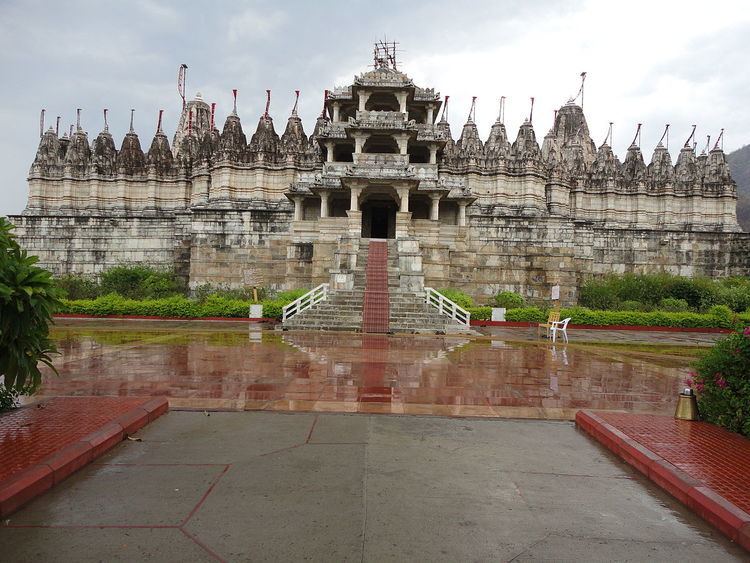Location Ranakpur, Rajasthan Deity Rishabhanatha Creator Dharna Shah | Affiliation Jainism Festivals Mahavir Jayanti Phone 077420 14733 | |
 | ||
Address Desuri Tehsil, Near Sadri, Pali, Sadri, Rajasthan 306702 Similar Jain temple, Dilwara Temples, Kumbhalgarh, Jagdish Temple - Udaipur, City Palace - Udaipur | ||
Seven wonders of india ranakpur jain temples aired march 2000
The renowned Jain temple at Ranakpur is dedicated to Tirthankara Rishabhanatha.
Contents
- Seven wonders of india ranakpur jain temples aired march 2000
- Ranakpur jain temple rajasthan
- Architecture
- History
- References
Dharna Shah, a local Jain businessperson, started construction of the temple in the 15th century following a divine vision. The temple honors Adinath, the first Tirthankar of the present half-cycle (avasarpiṇī) according to Jain cosmology. The town of Ranakpur and the temple are named after the provincial ruler monarch, Rana Kumbha who supported the construction of the temple.
Ranakpur jain temple rajasthan
Architecture
Light colored marble has been used for the construction of this grand temple which occupies an area of approximately 60 x 62 meters. The temple, with its distinctive domes, shikhara, turrets and cupolas rises majestically from the slope of a hill. Over 1444 marble pillars, carved in exquisite detail, support the temple. The pillars are all differently carved and no two pillars are the same. It is also said that it is impossible to count the pillars. Also all the statues face one or the other statue. There is one beautiful carving made out of a single marble rock where there 108 heads of snakes and numerous tails. One cannot find the end of the tails. The image faces all four cardinal directions. In the axis of the main entrance, on the western side, is the largest image. The moolnayak of this temple is a 6 feet tall white colored idol of Adinatha.
The temple is designed as chaumukha—with four faces. The construction of the temple and quadrupled image symbolize the Tirthankara's conquest of the four cardinal directions and hence the cosmos. The architecture and stone carvings of the temple is based on the Ancient Mirpur Jain Temple at Mirpur in Rajasthan.
The sun temple at Ranakpur dates back to the 13th century CE. After its destruction, it was rebuilt in the 15th century.
A temple dedicated to Suparshvanatha is also present here. The temple has an intrinsic architecture & this temple is also famous for erotic arts on the wall.
Māru-Gurjara Architecture show the deep understanding of structures and refined skills of Rajasthani craftmen of bygone era. Māru-Gurjara Architecture has two prominent styles Maha-Maru and Maru-Gurjara. According to M. A. Dhaky, Maha-Maru style developed primarily in Marudesa, Sapadalaksha, Surasena and parts of Uparamala whereas Maru-Gurjara originated in Medapata, Gurjaradesa-Arbuda, Gurjaradesa-Anarta and some areas of Gujarat. Scholars such as George Michell, M.A. Dhaky, Michael W. Meister and U.S. Moorti believe that Māru-Gurjara Temple Architecture is entirely Western Indian architecture and is quite different from the North Indian Temple architecture. There is a connecting link between Māru-Gurjara Architecture and Hoysala Temple Architecture. In both of these styles architecture is treated sculpturally.
History
The construction is well documented in a 1437 CE copper-plate record, inscriptions in the temple and a Sanskrit text Soma-Saubhagya Kavya. Inspired by a dream of a celestial vehicle, Dhanna Shah, a Porwal from Ghanerao, commenced its construction, under the patronage of Rana Kumbha, then ruler of Mewar. The architect who oversaw the project was named Deepaka. There is an inscription on a pillar near the main shrine stating that in 1439 Deepaka, an architect, constructed the temple at the direction of Dharanka, a devoted Jain. When the ground floor was completed, Acharya Soma Sundar Suri of Tapa Gachha supervised the ceremonies, which are described in Soma-Saubhagya Kavya. The construction continued until 1458 CE.
The temple was renovated time to time. Some famililies supported the construction of devakulikas and mandaps. The descendants of Dharna Shah now mainly live in Ghanerao. The temple has been managed by the Anandji Kalyanji Pedhi trust in the past century.
